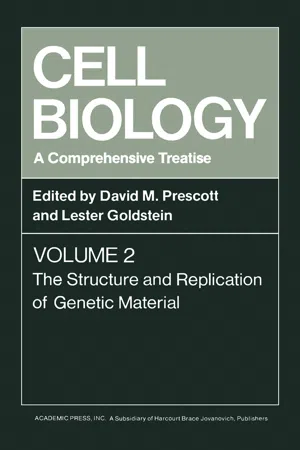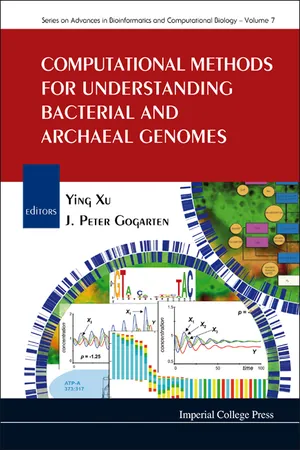Biological Sciences
Nucleoid Region
The nucleoid region is a distinct area within a prokaryotic cell where the genetic material, typically a single circular chromosome, is located. It lacks a membrane-bound nucleus and is found in organisms such as bacteria and archaea. The nucleoid region plays a crucial role in the organization and regulation of genetic material within the cell.
Written by Perlego with AI-assistance
Related key terms
1 of 5
4 Key excerpts on "Nucleoid Region"
- eBook - PDF
Cell Biology A Comprehensive Treatise V2
The Structure and Replication of Genetic Material
- David M. Prescott(Author)
- 2012(Publication Date)
- Academic Press(Publisher)
In addition, this chapter is not intended to be comprehensive. In an area as intensively studied as prokaryotic chromosomes, it has been necessary to limit the discussion to certain subjects and approaches. II. GROSS ORGANIZATION OF PROKARYOTIC CHROMOSOMES A. Structure of the Bacterial Nucleoid in Vivo The bacterial chromosome (or nucleoid) can be visualized in the cell by a variety of different microscopy techniques (for reviews, see Ryter, 1968; Pettijohn, 1976). In all cases, the nucleoid is seen to occupy only a portion of the intracellular volume; however, no nuclear membrane or other structural components segregates it from the cytoplasm. Apparently, in-teractions within the structure define its state of condensation. The size and shape of the nucleoids vary when cells are grown in various media or under different conditions (see Figure 1). When cells of E. coli are grown in rich media, the apparent surfaces of the nucleoids appear more uneven and convoluted than those seen in cells growing slowly in minimal media (Ryter and Chang, 1975). When protein synthesis or RNA synthe-sis is inhibited, the nucleoids can change in size and shape (Kellenberger et al., 1958; Daneao-Moore and Higgins, 1972; Dworsky and Schaechter, 1973). It seems that the structure of the nucleoid is dynamic in the sense that at least its gross organization is dependent on the physiological state of the cell. Also, the gross appearance of the nucleoids varies among the different bacterial strains. For example, in Bacillus subtilis the nucleoids tend to be smaller and more compact than in E. coli. It has been suggested that the intracellular nucleoids visualized by mi-croscopy represent only the tightly condensed genetically inactive DNA of the chromosome (Ryter and Chang, 1975) that perhaps is analogous to heterochromatin. DNA sequences containing actively transcribed genes 4 David E. Pettijohn and Jonathan O. Carlson Fig. 1. Electron micrographs of thin sections of E. coli cells. - eBook - PDF
- Joseph W. Lengeler, Gerhart Drews, Hans G. Schlegel(Authors)
- 2009(Publication Date)
- Wiley-Blackwell(Publisher)
354 The Genetics of the Prokaryotes and Their Viruses concentrations. Upon expansion of the DNA. a structure can be seen in electron micrographs with loops emerging from a central mass. The loops are mostly supercoiJed. and it is assumed that the loops constitute separate supen:oil domains of the chromosome (Fig. 14.13). Within the cells. nuc1eoids are those cytoplasmic regions that are (relatively) free of ribosomes. Due to the size of the chromosome relative to the bacterial cell (1.3 mm to 3 e.g., for E. coli), DNA in nucleoids is densely p.1cked and is not easily penetrated by enzymes such as RNA polymerase or by ribosomes. Therefore. transcriptional activity is probably not associated with the bulk of the DNA in the nucleoids. but is restricted to its surface. We can imagine that the supercoil loops protrude into the region containing RNA polymerase and ribosomes. and that the entire structure is very dynamic. P' ,f I'. _Iqions __ ..... iIl.whkh DNA Is cJonseIy p;lckod. They...., not$llmlllltdOd by • 1lUdNr _mIIt-. and aft _ lsoIaled by JysIs at hilhsak- The lack of a nuclear membrane around nucleoids has far-reaching consequences. Newly synthesized mRNA does not have to pass through a membrane. While it is synthesized. it is captured by ribosomes to form polysomes and is translated. This direct coupling of transcription and translation makes gene expression fundamentally different in prokaryotes and eukaryores. The correlation between replication, nucleoid segrega- tion, and cell division is described in Chapter 22. 14.3 Plasmids Are Independent Replicons Naturally occurring plasmids range in size from a little more than I kb up to several hundred kilobasepairs. They are independent replicons; the vast majority of them are circular. The exceptions again are found in Streptomyces and Borrelia and in Rhodococcus species that contain linear plasmids. Plasmids contain genes that are essential for plasmid maintenance. - Ying Xu, Johann Peter Gogarten(Authors)
- 2008(Publication Date)
- ICP(Publisher)
Plasmids and phages can be lost from a strain during laboratory cultivation on artificial medium and, as noted above, different strains of a bacterial species might 4 J. Mr´ azek & A. O. Summers be very similar at the chromosomal level yet have a completely different complement of plasmids. Thus, the term “genome” or even “complete genome” must be taken with the caveat that it can only refer to the DNA sequence of a particular strain at the time it was sequenced. The chromosomes and very large ( > 400 kb) plasmids can be quite stable in many genera. However, the variable (or mobile) fraction which can constitute 10 to 12% of the genetic information in freshly cultivated isolates of some genera will likely not be the same in every sequenced example of the species. 1.2. Physical Organization of Replicons in the Cell Eukaryotic cells are compartmentalized and the chromosomes are located in the nucleus, which has been extensively studied for a century and a half. On the other hand, prokaryotic cells are not compartmentalized and investigations of the detailed physical structure and organization of chromosomes in prokaryotic cells are more recent. Most well studied bacteria and archaea have circular chromosomes that replicate bidirectionally from a single origin, although spirochetes, Streptomyces , and a few other bacteria (Hinnebusch and Tilly, 1993) have linear chromosomes, and some archaea have more than one origin of replication (Mr´ azek and Karlin, 1998; Myllykallio et al. , 2000; Robinson et al. , 2004). Prokaryotic chromosomes are not enclosed in a separate compartment, but their physical structure is nonetheless highly ordered. The organized DNA structure in prokaryotic cells is referred to as the nucleoid and includes DNA as well as proteins that contribute that help stabilize the nucleoid structure. Compared to eukaryotic chromatin the bacterial nucleoid has a low protein content.- eBook - ePub
- Alexander McLennan, Andy Bates, Phil Turner, Michael White(Authors)
- 2012(Publication Date)
- Taylor & Francis(Publisher)
SECTION C – PROKARYOTIC AND EUKARYOTIC CHROMOSOME STRUCTURE
Passage contains an image
C1 Prokaryotic chromosome structure
Key Notes The prokaryotic chromosome The single E. coli chromosome is a closed-circular DNA of length 4.6 million base pairs that resides in a region of the cell called the nucleoid. In normal growth the DNA is being replicated continuously. Many prokaryotes also contain plasmid DNAs while some have multiple chromosomes. DNA domains The E. coli genome is organized into 50–100 large loops or domains of 50–100 kb in length, which are constrained by binding to a membrane—protein complex. Supercoiling of the genome The genome is negatively supercoiled. Individual domains may be topologically independent and so are able to support different levels of supercoiling. DNA-binding proteins The DNA domains are compacted by wrapping around nonspecific DNA-binding proteins such as HU and H-NS (histone-like proteins). These proteins constrain about half of the supercoiling of the DNA. Other molecules such as integration host factor, RNA polymerase and mRNA may help to organize the nucleoid. Related topics (B3) DNA supercoiling (C4) Genome complexity (C2) Chromatin structure The prokaryotic chromosome
Prokaryotic genomes vary in size from the 0.16 Mb of the tiny insect endosymbiont Carsonella ruddi to the 13 Mb of the soil bacterium Sorangium cellulosum . Most of these have one chromosomecontaining a single, closed circular Section B3 DNA molecule. The 4.6-Mb E . coli chromosome is fairly typical. This DNA is packaged into a region of the cell known as the nucleoid, although the nucleoid is not bounded like the eukaryotic nucleus. This region has a very high DNA concentration, perhaps 30–50 mg mL−1 , as well as containing all the proteins associated with DNA, such as polymerases, transcription factors, and others (see below). A fairly high DNA concentration in the test tube would be 1 mg mL−1 . In normal growth, the DNA is being replicated continuously and there may be on average around two copies of the genome per cell, when growth is at the maximal rate (Section D2
Index pages curate the most relevant extracts from our library of academic textbooks. They’ve been created using an in-house natural language model (NLM), each adding context and meaning to key research topics.



